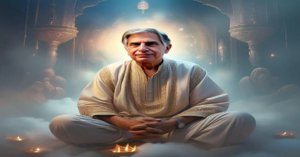Ratan Tata net worth in billion without charity
Discover Ratan Tata Billion-Dollar Net Worth, Beyond Charity

Ratan Tata net worth shows his life’s work in leading the Tata Group. He has been a key player in India’s industry, touching sectors from steel to tech. This piece looks into how his wealth grew through smart decisions and business expansion.
See how his wealth goes beyond giving to charity, focusing on his business ventures and new ideas. It’s about the economic foundations that made Tata Group a lasting success in India.
Key Takeaways
- Ratan Tata’s net worth is rooted in decades of industrial expansion and global partnerships.
- His billionaire legacy combines innovation in sectors like automotive and energy.
- The article examines wealth generation separate from charitable activities.
- Key financial milestones reveal a focus on sustainable business models.
- Readers gain insights into the wealth management practices of top Indian entrepreneurs
Ratan Tata – Industrialist and Philanthropist
Ratan Tata is a true leader in the business world. As an Ratan Tata industrialist, he has grown the Tata Group globally. He has changed many industries, from cars to tech, by bringing new ideas.
His work in giving back is just as impressive. He focuses on education, health, and helping after disasters. His efforts have helped millions in India, both in cities and rural areas.
| Industrial Contributions | Philanthropic initiatives |
| Automobiles (Tata Motors) | Educational institutions support |
| IT & Telecom (TCS) | Healthcare infrastructure |
| Steel production | Rural development programs |
He has made a big impact through his business and charity work. His work shows that success and helping others can go hand in hand. He is a true example of ethical leadership in India.
Understanding the Billion-Dollar Legacy
Ratan Tata’s journey shows how big decisions can create a lasting legacy. This part looks at historical milestones and their impact on India’s economic growth timeline.
Historical Milestonesof Growth
Important events have shaped Tata’s influence :
- 1868 : JN Tata founded the Tata Group, starting India’s first industrial enterprise.
- 1991: Ratan Tata took leadership, expanding into engineering and services.
- 2008 : acquisition of UK’s Corus Steel, marking first major global takeover.
- 2009 : Launch of Tata Nano, aiming to make cars accessible.
Economic Impact Over Time
A timeline shows how these milestones drove progress:
| Year | Economic Impact |
| 1991–2000 | Post-liberalisation expansion into 100+ countries |
| 2008–2010 | Corus acquisition doubled Tata Steel’s global market share |
| 2010–2020 | Investments in renewable energy and tech spurred job creation |
These steps show how Tata’s strategic moves matched India’s economic changes. They highlight Tata’s role in driving national development.
Inside the Empire of the Tata Group
The Tata Group has become a major force in India. It has grown through diversified business strategies. It covers everything from making things to tech, aiming to lead worldwide while helping locally.
Diversified Business Ventures
The group has moved into new areas. It now works in:
- Automobiles: pioneering brands like Tata Motors and Jaguar Land Rover
- IT Services: Global leaders like Tata Consultancy Services (TCS)
- Energy : Renewable projects and power generation
- Retail : BigBasket and other consumer-focused platforms
Innovation Across Industries
Ratan Tata once said, “Innovation demands curiosity and courage.”
They’ve made big strides in AI and 5G. They’re also big on electric cars and clean energy. Their fintech efforts have made digital payments easy for millions in India. These steps keep them ahead in a quickly changing world.
Net worth in billions without charity
To understand Ratan Tata’s net worth in billions without charity, we need to look at his financial portfolio closely. This part explains how his wealth is made up, excluding donations. It focuses on his main assets and smart investments.
Asset Distribution and Investments
Ratan Tata’s wealth comes from a variety of investments. The main areas are:
- Automobiles (Tata Motors and Jaguar Land Rover)
- Steel (Tata Steel)
- Technology (TCS and Tata Consultancy Services)
- Energy and materials
Examining the Financial Portfolio
His financial portfolio aims for long-term growth. It focuses on:
| Sector | Percentage |
| Manufacturing | 45% |
| Information Technology | 25% |
| Services | 20% |
| Real Estate | 10% |
This mix helps reduce risk and take advantage of market trends. Smart buys and partnerships also add to his wealth.
Fortune Growth: Wealth Beyond Charity

Ratan Tata’s financial success goes beyond just giving to charity. He focuses on private investments that grow his wealth over time. This way, his wealth and charity work stay separate.
Private Investments and Earnings
His investments in IT and infrastructure are key. Tata Consultancy Services (TCS) and the Mumbai-Pune Expressway are examples.
- Automobile ventures such as Tata Motors
- Steel and chemicals divisions are maintaining global supply chains
Separating Charity from Business Wealth
Ratan Tata manages his wealth carefully, keeping business and charity apart. His business decisions aim for profit, while charity is handled by the Tata Trusts. This approach protects his business growth and keeps his wealth strong.
Key Investments that Shaped the Wealth
Ratan Tata’s key strategic investments have been the foundation of his wealth. He chose sectors like automotive and IT, knowing they would grow.
These choices allowed him to benefit from India’s tech and consumer growth.
- Infrastructure Plays: Tata Power and Tata Elxsi investments met urbanisation needs, securing long-term gains.
Tata also made innovative choices, like in renewable energy and global partnerships. His focus on automotive and technology showed his vision. These investments not only increased his wealth but also shaped India’s industry.
His forward-thinking, like investing in nanocars and green tech startups, continues to influence his legacy.
The Role of Global Markets in Wealth Expansion
Ratan Tata’s financial strategy has always looked to the world beyond India. By exploring markets in Europe and North America, the Tata Group found new ways to make money. These international ventures brought in more income and helped reduce risks tied to one region.
International Ventures and Trade
- Tata Motors’ big move in 2008 was buying Jaguar Land Rover (JLR).
- Steel and telecom trade deals helped reach more customers, using India’s low costs.
- Team-ups with Tetley and Titan boosted the brand’s global image.
Economic Policies and Market Trends
Keeping up with changes like Brexit and US trade rules was a challenge. Tata’s teams watched currency changes and tax updates closely to safeguard their investments. For example:
- Investments in green energy matched global trends towards sustainability.
- Deals with ASEAN countries tapped into growing markets.
The 2008 crisis was a test, but it also opened up new chances. Tata’s commitment to long-term growth helped it stay strong. This mix of planning and quick thinking has shaped the group’s global reach.
Navigating the Economic Climate in India
Understanding the Indian economic climate is key to grasping Ratan Tata’s strategic decisions. Fluctuations in sectors like manufacturing and tech shape how businesses adapt. Local market trends, such as rising consumer demand and digital adoption, drive innovation.
| Economic Indicator | 2023 Data |
| GDP Growth Rate | 6.8% |
| Manufacturing Output | 7.2% increase |
| FDI Inflows | $85 billion |
Local market trends highlight opportunities in renewable energy and infrastructure. Tata Group’s focus on solar power aligns with policy shifts toward sustainability. Rising middle-class spending also boosts consumer goods demand, influencing retail investments.
“Adaptability to the Indian economic climate defines long-term success.”
- Increased e-commerce penetration impacts traditional retail models
- Government policies on Make in India drive manufacturing
- Urbanisation fuels demand for housing and transport solutions
Monitoring these factors helps businesses like Tata Industries balance risks and growth. The local market trends in 2023 show a resilient economy, opening pathways for expansion while requiring agile strategies.
Analysing Financial Strategies and Success
Ratan Tata has changed the Tata Group’s path with smart financial moves. He mixes careful planning with daring steps. This mix keeps the group growing.
“Innovation drives progress, and strategic moves define success.” — Ratan Tata
Risk Management and Innovation
The Tata Group’s success comes from smart financial plans. Key steps include:
- Investing in R&D for tech advancements
- Expanding into renewable energy sectors
- Maintaining diversified revenue streams
These steps help the group stay strong when markets change.
Strategic Acquisitions
Big buys like Tetley Tea and Corus Steel have grown the group’s global reach. They also made more money. Each deal helps the group’s long-term goals, creating new chances in different areas.
The £1.1 billion Corus Steel deal in 2007 made Tata Steel stronger in Europe.
These big moves show Tata’s aim to grow without spending too much.
Legacy and Impact on Indian Business Culture
Ratan Tata’s legacy in Indian business is profound. It has shaped corporate culture for years. His work has made innovation and social responsibility key values in the country’s economy.
His efforts in education and healthcare have set high standards for ethical business. This has made a lasting impact.
“True leadership is when you work for others.” — Ratan Tata
Influence on Future Generations
Young entrepreneurs now focus on long-term impact more than quick profits. Tata’s push for sustainability has inspired new policies. The Tata Sustainability Framework is now adopted by many new companies.
His vision showed that businesses can be profitable and do good at the same time. Today, Indian businesses are following his model of growth that includes everyone. His legacy lives on in boardrooms and communities across the country.
Shaping Brand Image
The Tata Group focuses on sustainable practices and CSR. Media talks about their $1.8 billion healthcare investments through the Tata Trusts. They also make sure their brand looks consistent everywhere, from ads to events.
- Focus on eco-friendly projects
- Stories of community support in local media
Public Relations and Communication
The Tata Group is good at talking to the media. During the pandemic, they gave updates on vaccine distribution. This showed they were accountable. They also talk to employees and customers on social media to build trust.
- Quarterly press briefings on sustainability goals
- Collaborations with journalists for balanced reporting
Conclusion
Ratan Tata’s journey shows a mix of smart planning and doing the right thing. He grew the Tata Group into big areas like cars, energy, and health. His moves, like buying Corus Steel and growing Tata Motors, were bold and paid off big time.
Tata’s wealth is more than just money; it stands for new ideas and caring for society. His work in green energy and education shows he values both making money and making a difference.
FAQ
How does Ratan Tata separate his business from charity?
Ratan Tata keeps his business and charity work separate. He makes money through investments but gives to charity through the Tata Trusts. This way, his business and charity work don’t mix.
What strategies has Ratan Tata employed for wealth growth?
Ratan Tata has grown his wealth in many ways. He has made smart buys, entered new markets, and used new technology. This has helped him stay ahead globally.
How has globalisation influenced Ratan Tata’s business strategies?
Globalisation has helped Ratan Tata reach more markets. He has made investments and partnerships abroad. This has made the Tata Group bigger worldwide.
Leave a Reply
Want to join the discussion?Feel free to contribute!